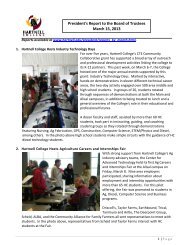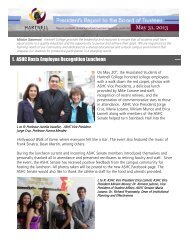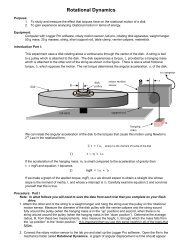Accreditation - Hartnell College!!
Accreditation - Hartnell College!!
Accreditation - Hartnell College!!
Create successful ePaper yourself
Turn your PDF publications into a flip-book with our unique Google optimized e-Paper software.
Institutional Self Evaluation – 12-05-12<br />
with before they become big problems. The head of HR, for instance, meets with the head of<br />
the employee groups on a regular basis, as does the president of the college. In these<br />
meetings, concerns are discussed and collaborative solutions are explored, with a goal of<br />
empowering the employee or groups of employees to participate in creating the solution that<br />
they need.<br />
The student government and student groups were actively involved in the redesign of the<br />
college center, completed in 2010. This redesign created new office, meeting, and recreation<br />
space for students, a coffee bar, new lounge areas, and a home for the student government. A<br />
student life coordinator is jointly funded by the student government and the District, and acts<br />
as a direct link between the students and the administration of the college. Students are<br />
represented on all shared government committees, and their contributions are valued on<br />
hiring committees.<br />
The District‘s integrity is also demonstrated in the way that it handled negotiations over a<br />
budget crisis in 2009, and the ensuing negotiations over health and welfare benefits.<br />
In the summer of 2009, when the state‘s financial situation created a budget shortfall for<br />
<strong>Hartnell</strong> of about $3.3 million, the college president called a meeting of the Resource<br />
Allocation Committee and the Cabinet, and outlined the situation the college was in. The<br />
group took on the task of finding solutions, such as identifying areas where efficiencies could<br />
be created, or ways to reduce expenditures. The group and related shared governance<br />
committees met throughout the summer to come up with solutions. Nothing was off-limits.<br />
At the end of that work, the group had found $1.6 million in savings. That left $1.7 million<br />
that they handed over to the employee groups to negotiate. The groups met continuously with<br />
the District, and each group was allowed to come up with its own way to meet its share of<br />
concessions. That process, which could have caused anger and strife, actually unified the<br />
employees, who were allowed to participate in the decision-making about concessions.<br />
One of the factors that all groups realized during that summer was that the cost of health<br />
insurance had gotten too steep. Prior to 2009, each employee group was treated as a separate<br />
entity for purposes of health insurance. Each group negotiated a ―cap,‖ which represented the<br />
monthly amount that the District would pay toward each employee‘s medical benefits. Within<br />
each group, each employee had the same monthly cost of insurance. This composite rate was<br />
arrived at by combining the costs of the whole group and dividing that cost evenly among<br />
employees. Although this method was contained in each bargaining agreement and embraced<br />
by the District and the employees, it produced three results that were considered unfair. One,<br />
each group‘s cap might differ due to the group‘s negotiation success. Two, each group‘s<br />
composite rate would differ depending on the distribution of employees in different insurance<br />
tiers: single, employee plus one, or family coverage. Groups with higher numbers of families<br />
had higher costs. And three, all single employees, regardless of their group, subsidized the<br />
families in a composite scheme. As a matter of policy, the unions did not mind this fact, but<br />
the District heard many complaints from employees about the unfairness of this situation.<br />
The year after the employee concessions, the District proposed to each union to move away<br />
from the composite rate and instead use a scheme whereby the District would pay the entire<br />
Page 213

















